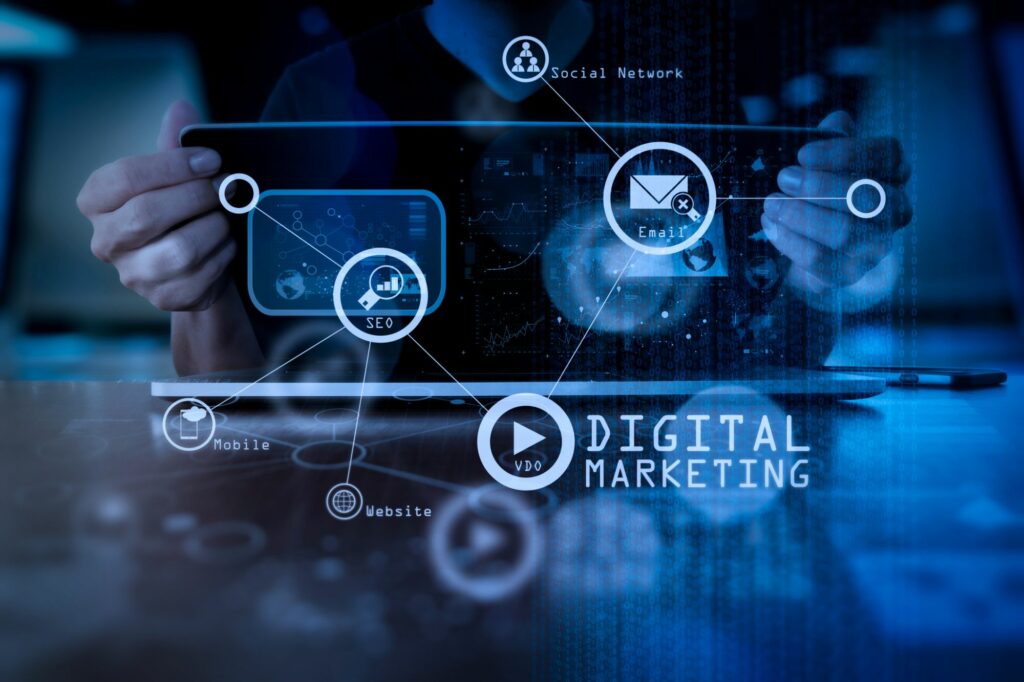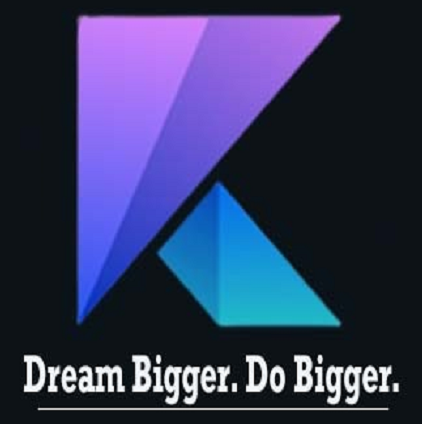Digital Marketing Strategy

With the help of a digital marketing strategy, you can reach out to your current clientele as well as people who might be interested in what you have to offer by utilizing a variety of online tools, such as social media, pay-per-click advertising, search engine optimization, and electronic newsletters. Because of this, you can establish credibility, delight clients, and attract new ones.
Just what does “digital marketing” entail?
When businesses use the internet and other types of digital communication to reach out to potential clients, this practice is known as digital marketing or online marketing. The term “digital marketing” encompasses a wide range of methods, such as email, social media, and online ads, as well as text and multimedia messaging.
In its most basic form, digital marketing is any form of advertising that takes place in the digital realm.
Digital vs. inbound marketing
The terms “digital marketing” and “inbound marketing” are often used interchangeably, and not without good reason. A lot of the same tactics used for inbound marketing can also be used for digital marketing, including email and web content. Both are in existence to attract and convert leads into paying clients at various stages of the sales funnel. The two methods, however, regard the instrument and the result in very different ways. The goal of digital marketing is to increase sales, and one aspect of this is looking at how various digital marketing platforms might influence potential customers. Digital marketing for a brand may involve using a variety of channels, or it may concentrate on just one. One common mistake is focusing solely on one or two types of digital marketing, such as social media or email marketing. However, inbound marketing takes a more all-encompassing approach. It starts with the end in mind, analyses the tools at hand to figure out which would most efficiently reach the desired clients, and then decides when in the sales funnel that should occur. Let’s imagine, for the sake of argument, that you wish to increase site visits to expand your pool of potential customers. Search engine optimization (SEO) can be prioritized at the planning stages of a content marketing strategy, leading to better-optimized content across the board.
Marketers should keep in mind that they can use both digital and inbound strategies to achieve their goals. They complement each other very well. Effective digital marketing requires structure and purpose, which inbound marketing provides by ensuring that all digital marketing channels contribute to a larger objective.
What are the benefits of using digital marketing?
Your company can benefit from advertising of any kind. In contrast, the widespread availability of digital channels has boosted the significance of digital marketing. In April of 2022, there were 5 billion people online around the world. You can reach your demographic through a variety of digital marketing channels, from social media to SMS. Additionally, the start-up costs for digital marketing are low, making it a reasonable choice for even the smallest firms.
In terms of digital marketing, business-to-business (B2B) campaigns often outperform consumer-facing campaigns.
Business-to-business (B2B) and business-to-consumer (B2C) organizations can both benefit from digital marketing tactics, but B2B and B2C companies have quite different digital marketing best practices. Examining the use of digital marketing in business-to-business and business-to-consumer campaigns.
Customers in the business-to-business sector typically take more time making purchases, leading to lengthier sales cycles. This clientele responds better to long-term techniques like relationship building than B2C customers do to short-term ones like offers and messaging.
Skilled B2B digital marketers give proof and rationale to support their products and services, the foundation of most business-to-business deals. A common trend in business-to-consumer communication is an emphasis on the reader’s or viewer’s positive emotions in connection with the product being promoted.
It usually takes more than one individual to weigh in on B2B decisions. Marketing materials that are easily shared and downloaded tend to have the greatest impact on these kinds of choices. However, business-to-consumer clients value more personalized interactions with brands.
There are always going to be a few outliers. One could expect more serious and instructive information from a business-to-consumer firm selling an expensive product like a car or computer. Therefore, whether you’re selling to other businesses or consumers, your digital marketing efforts should always be directed at your core audience.
If you want to make informed and effective choices about your internet marketing strategies, it’s important to take a close look at your present audience. By doing so, you increase the likelihood that your advertising will reach its target audience.
Various Forms of Online Promotion
It’s been said that the number of sub-fields within digital marketing is roughly equal to the number of different ways people can communicate via the web. Some of the most common strategies used in digital marketing are outlined here.
Effective Optimization for Search Engines
Technically speaking, SEO is not a type of marketing but rather a method of marketing. As defined by The Balance, SEO is “the art and science of making web pages desirable to search engines.”
Search engine optimization relies heavily on both art and science. To attain the best potential position on a search engine results page, SEO requires in-depth investigation and careful consideration of a wide variety of contributing elements (SERP).
To optimize a website for search engines today, the most crucial factors to think about are:
Having high-quality content, an active user base, and a mobile-friendly design are all factors.
Consider both the quantity and quality of links coming in.
Technical SEO, or the optimization of your site’s back end, is just as important as the aforementioned factors. Factors such as page load times, broken links, and URL structure all have a role. Boosting your site’s technical SEO can make it easier for search engines to index your content.
Search engine optimization is both a science and an art due to the strategic usage of these variables.
The end game is to make it onto the first page of Google’s search results. This makes it so that anyone looking for your brand can quickly find the items or services you offer. There are a lot of other search engines out there, but digital marketers tend to zero in on Google because it’s the industry standard.
When it comes to search engine optimization, there is no set of rules or metrics that can guarantee first-page results. Due to the frequent algorithm updates implemented by Google and competing search engines, accurate forecasts are currently unachievable. You can improve your strategy by keeping a careful eye on how visitors interact with your page.
Read More: Best Cloud Computing
Advertising with written content

It has been established that excellent content is crucial to a well-optimized website. Therefore, search engine optimization is crucial to content marketing, the dissemination of useful and relevant material to an intended audience.
Advertising on social media
Marketing in the social media realm is encouraging participation in online conversations to increase site visits and exposure to the business in question. To promote your business, goods, services, culture, and more, try using social media advertising. Focusing on social media marketing can pay off because billions of people use these sites every day.
Facebook, Twitter, and Instagram are the most widely used social media marketing channels on the internet, followed by LinkedIn and YouTube. Which social media sites you choose to promote your business on is determined by your objectives and target demographic. For instance, LinkedIn is a great place to find new leads for your FinTech firm because so many people in the sector use it every day. Conversely, if you’re a B2C company aiming to attract a younger demographic of customers, you might do better by advertising on Instagram.
The popularity of social media marketing can be attributed to the fact that it encourages engagement on the part of the target audience. For B2C digital marketers, it is the most common content medium at 96%, and it is also rapidly expanding in the B2B sector. The majority of B2B content marketers (61%) have upped their social media usage this year, according to data from the Content Marketing Institute.
Measuring the success of your social media marketing campaign is made easier with the help of built-in engagement indicators. Choose the metrics that matter to you, whether it’s the number of shares, comments, or total clicks to your website.
You might not even intend for people to make a direct purchase as part of your social media marketing campaign. Instead of trying to get customers to spend money immediately, many companies are using social media marketing to establish conversations with their target demographics. This is especially prevalent among brands aimed at a mature demographic or selling services that aren’t suitable for on-the-spot purchases. It’s important to think about the final result you want from your social media marketing efforts as a business.
Developing a successful social media marketing plan requires adhering to established standards. Some of the most crucial rules of social media advertising are as follows:
Affiliate marketing that relies on a pay-per-click model
Pay-per-click (PPC) advertising is a model of online promotion in which the advertiser forks up cash each time one of their adverts is clicked. This means that you don’t have to commit to a monthly budget for running targeted advertising across internet channels; rather, you’ll only be charged for the ads that receive click-throughs. Complicating matters further is the question of when and how your advertisement will be seen.
Search engine advertising is a popular form of pay-per-click (PPC) marketing, and many companies turn to Google Ads for this purpose because it is the most widely used search engine. If there is empty real estate on a SERP (Search Engine Results Page), the engine will conduct what amounts to a live auction to fill it. Each accessible ad is assigned a priority by an algorithm based on a variety of criteria, such as:
Contextual advertising
Affiliate marketing is a form of online advertising in which one party benefits financially from the promotion of another. Both the promoter and the business working with them go through the same steps.
A split of the profits is how it all works. If you’re an affiliate, every time one of your referrals makes a purchase, you get a cut of the profits. The affiliate receives a commission from the business for each sale they generate.
There are affiliate marketers who choose to focus on reviewing products from a single firm on their blog or another unbiased website. Some people have connections with numerous vendors.
The first step in becoming an affiliate or finding one is establishing communication with the other party. Affiliate marketing programs can be started or joined on a retailer-by-retailer basis, or through the use of digital channels specifically designed to link affiliates with merchants.
There are several things you can do as a merchant to make your affiliate program more attractive to potential promoters. The key to helping your affiliates thrive is giving them the resources they need. That consists of marketing resources, such as templates and incentives for exceptional achievements.
Promoting products in their natural environment
It’s digital marketing in disguise, but it looks like native advertising. So that it doesn’t stand out as obviously as advertising, it aims to blend in with the information around it.
The skepticism that modern consumers have toward advertisements inspired the development of native advertising. Many people, upon learning that an advertisement’s designer also foots the bill for its dissemination, automatically write it off as biased propaganda and never give it another thought.
A native ad sidesteps this prejudice by providing value in the form of information or amusement before promoting a product or service.
Always make sure your native advertisements are properly labeled. Terms like “sponsored” and “promoted” can be used. Without those clues, readers may spend a long time interacting with the content before they discover its advertising.
When readers have no doubts about what they’re getting, they get a more positive impression of both your content and your brand. While native advertisements aim to be less intrusive than standard ads, they should not be misconstrued as being part of the content they surround.
Promote your products with the help of influential people

Similar to affiliate marketing, influencer marketing involves exchanging promotional support for the endorsement of a well-known figure (an influencer) like a celebrity, expert, or content provider. These people have large followings on multiple social media platforms and are willing to spread the word about your business.
Both business-to-business and business-to-consumer brands can find success with influencer marketing. In this case, the influencer is acting as a representative for your brand, thus it’s crucial that you only work with trustworthy individuals. The credibility of your brand might be damaged by associating with the wrong kind of influencer.
Software that automates marketing processes
Marketing automation is the use of software to fuel digital marketing initiatives, increasing the effectiveness and relevance of advertising. Your time and energy can be better spent on your digital marketing strategy rather than dealing with tedious administrative tasks.
Marketing automation may seem like a frivolous investment for your company, but it may help you connect with your target audience far more effectively.
Develop customer-specific advertising strategies
Distribute and publish your digital marketing content at optimal times and to targeted demographics.
The level of interaction a prospect has with a marketing message (or lack thereof) is often used by marketing automation software to determine the best time and method to follow up with that person. With this degree of real-time personalization, you can effectively develop a unique marketing approach for each customer with little to no extra effort.
The marketing automation features offered by MailChimp make it possible to communicate with your target audience in a variety of different ways, including through automated responses to their actions, in-app notifications, and automated sending of emails on specific dates.
Tips for developing a successful online advertising plan
The initial steps of implementing a digital marketing strategy can be daunting for many small firms and novice digital marketers. To boost your brand’s visibility, readership, and sales, however, you need a solid digital marketing strategy.
It’s important to use the SMART method while setting your goals.
The success of any marketing plan depends on setting SMART goals that are both realistic and timely. There may be numerous objectives you set for yourself, but it’s important to zero in on those that will move your strategy forward.
Get More: E-Commerce Website
Think about whom you’re writing for.
It’s important to know whom you’re trying to reach before launching a marketing effort. Group of persons who have some characteristics with your campaign’s intended recipients, such as age, gender, demographics, or shopping habits. You can tailor your digital marketing channels and content to your audience better if you know whom you’re talking to.
Make a plan for spending your money
Expenditure money wisely on digital marketing platforms that may not deliver the expected outcomes can be difficult without a budget to guide your spending. When preparing your budget, keep in mind both your SMART goals and the digital channel you intend to use.
Pick the appropriate online marketing platforms.
There are several avenues open to you in the realm of digital marketing, from pay-per-click (PPC) advertising to content marketing and beyond. The objectives, target demographics, and available resources will determine the digital marketing platforms you employ.
Tune up your advertising strategies.
After your campaign is complete, you should review the data to see what worked and what could be improved. That’s useful information for developing future successful campaigns. Using software and digital tools, you may compile this information into an understandable dashboard. You can monitor all of your advertising efforts from one convenient location with Mailchimp’s reports on digital marketing analytics.
Growth is a result of digital marketing.
Virtually every company needs to devote significant resources to digital marketing. There has never been a better time to use digital data because it allows for constant communication with clients and unparalleled customization. A company’s growth potential can only be realized to the extent that its leaders are willing to explore the opportunities offered by digital marketing.
